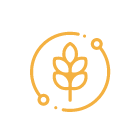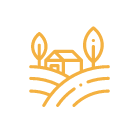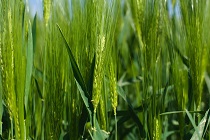



Sustainable agriculture is farming in sustainable ways, which means meeting society's present food and textile needs, without compromising the ability for current or future generations to meet their needs.[1] It can be based on an understanding of ecosystem services. There are many methods to increase the sustainability of agriculture. When developing agriculture within sustainable food systems, it is important to develop flexible business process and farming practices.[2]
Agriculture has an enormous environmental footprint, playing an outsized role in causing climate change, water scarcity, land degradation, deforestation and other processes;[3] it is simultaneously causing environmental changes and being impacted by these changes.[4] Developing sustainable food systems, contributes to the sustainability of the human population. For example, one of the best ways to mitigate climate change is to create sustainable food systems based on sustainable agriculture. Sustainable agriculture provides a potential solution to enable agricultural systems to feed a growing population within the changing environmental conditions
In 1907 Franklin H. King in his book Farmers of Forty Centuries discussed the advantages of sustainable agriculture, and warned that such practices would be vital to farming in the future.

Wild grains were collected and eaten from at least 105,000 BP. However, domestication did not occur until much later. Starting from around 9500 BC, the eight Neolithic founder crops – emmer wheat, einkorn wheat, hulled barley, peas, lentils, bitter vetch, chick peas, and flax – were cultivated in the Levant. Rye may have been cultivated earlier but this remains controversial. Rice was domesticated in China by 6200 BC with earliest known cultivation from 5700 BC, followed by mung, soy and azuki beans. Pigs were domesticated in Mesopotamia around 11,000 BC, followed by sheep between 11,000 BC and 9000 BC. Cattle were domesticated from the wild aurochs in the areas of modern Turkey and Pakistan around 8500 BC. Sugarcane and some root vegetables were domesticated in New Guinea around 7000 BC. Sorghum was domesticated in the Sahel region of Africa by 3000 BC. In the Andes of South America, the potato was domesticated between 8000 BC and 5000 BC, along with beans, coca, llamas, alpacas, and guinea pigs. Bananas were cultivated and hybridized in the same period in Papua New Guinea. In Mesoamerica, wild teosinte was domesticated to maize by 4000 BC. Cotton was domesticated in Peru by 3600 BC. Camels were domesticated late, perhaps around 3000 B
There is debate on the definition of sustainability regarding agriculture. The definition could be characterized by two different approaches: an ecocentric approach and a technocentric approach.[15] The ecocentric approach emphasizes no- or low-growth levels of human development, and focuses on organic and biodynamic farming techniques with the goal of changing consumption patterns, and resource allocation and usage. The technocentric approach argues that sustainability can be attained through a variety of strategies, from the view that state-led modification of the industrial system like conservation-oriented farming systems should be implemented, to the argument that biotechnology is the best way to meet the increasing demand for food
As the global population increases and demand for food increases, there is pressure on land as a resource. In land use planning and management, considering the impacts of land use changes on factors such as soil erosion can support long-term agricultural sustainability, as shown by a study of Wadi Ziqlab, a dry area in the Middle East where farmers graze livestock and grow olives, vegetables, and grains.[41]
Looking back over the 20th century shows that for people in poverty, following environmentally sound land practices has not always been a viable option due to many complex and challenging life circumstances.[42] Currently, increased land degradation in developing countries may be connected with rural poverty among smallholder farmers when forced into unsustainable agricultural practices out of necessity.[43]
Converting big parts of the land surface to agriculture have severe environmental and health consequences. For example, it leads to rise in Zoonotic disease like the Coronavirus disease 2019, by degrading natural buffers between humans and animals, reducing biodiversity and creating big groups of genetically similar animals